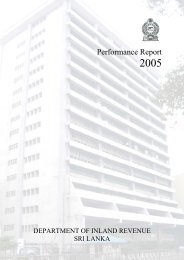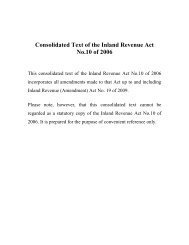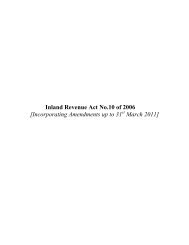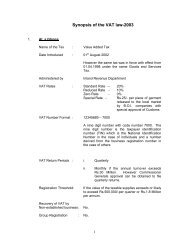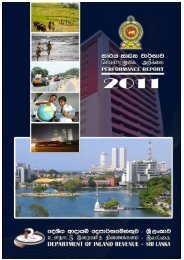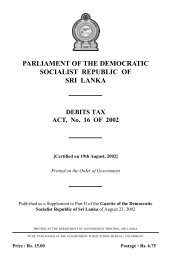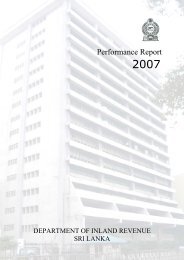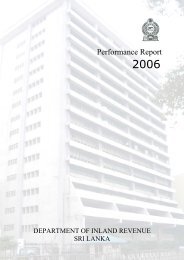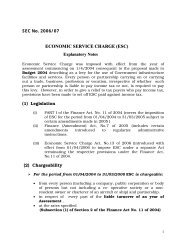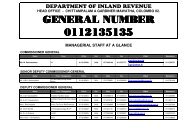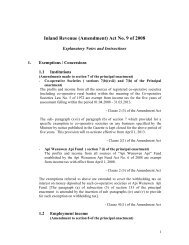VAT Guide to Value Added Tax - sri lanka inland revenue ...
VAT Guide to Value Added Tax - sri lanka inland revenue ...
VAT Guide to Value Added Tax - sri lanka inland revenue ...
You also want an ePaper? Increase the reach of your titles
YUMPU automatically turns print PDFs into web optimized ePapers that Google loves.
iv. Import of any fabric, yarn, grey cloth, finished cloths, chemicals and dyes used<br />
for the manufacture of fabric by a BOI company, entered in<strong>to</strong> an agreement<br />
under Section 17 of the BOI Law for the purpose of manufacture of fabric.<br />
v. Import of any ship (Vide Appendix 3 – Item 4)<br />
2.4.2 Exclusion of local supplies – Sec. 3<br />
<strong>VAT</strong> shall not be charged on the wholesale and retail supply of goods other<br />
than wholesale and retail supply by<br />
• a manufacturer of such goods<br />
• an importer of such goods<br />
• a supplier who is unable <strong>to</strong> satisfy the C.G.I.R. as <strong>to</strong> the source from which such<br />
goods were acquired.<br />
- However a person engaged in retail and wholesale sales can register voluntarily<br />
<strong>to</strong> charge <strong>VAT</strong> on such sales.<br />
- The evidence required with regard <strong>to</strong> acquisition of goods <strong>to</strong> satisfy the C.G.I.R<br />
has been published in a press notice on 07.07.2000. Please see para 15.3.<br />
(Excluded supplies are not within the purview of the <strong>VAT</strong> Act)<br />
2.5 Charging, Collection and payment of <strong>VAT</strong><br />
• As stated in para 2.2 above it is a Registered Person who can charge <strong>VAT</strong> on<br />
the supply of goods and services within Sri Lanka. He should charge and<br />
collect <strong>VAT</strong> from the recipients of “taxable supplies” of goods and services<br />
made by him. This should be done only in the course of a “taxable activity”<br />
carried on by him. <strong>VAT</strong> should be charged by him at the “time of supply”. The<br />
<strong>VAT</strong> chargeable is calculated on the “value of supply”.<br />
• Thus <strong>VAT</strong> is in fact paid by the “recipient” of goods and services (i.e<br />
consumer). It is paid <strong>to</strong> the “supplier” who should be a registered person. He<br />
collects <strong>VAT</strong> from the recipient (i.e his cus<strong>to</strong>mer) and remit the same <strong>to</strong> the<br />
C.G.I.R as provided in Section 22(i). Therefore <strong>VAT</strong> is paid in the first instance<br />
by the consumer <strong>to</strong> the registered person and then, by the Registered<br />
Person <strong>to</strong> the C.G.I.R.<br />
• A registered person is therefore responsible for charging and collecting <strong>VAT</strong><br />
on behalf of the C.G.I.R and account for such collections <strong>to</strong> the C.G.I.R in<br />
respect of supplies of goods and services made by him in Sri Lanka.<br />
• On imports <strong>VAT</strong> is paid by the importer and it is ’collected’ by the Direc<strong>to</strong>r<br />
General of Cus<strong>to</strong>ms who in turn remit it <strong>to</strong> C.G.I.R. – Section 2(3). However the<br />
DGC has delegated some of his powers <strong>to</strong> B.O.I. Vide para 5.11<br />
12



